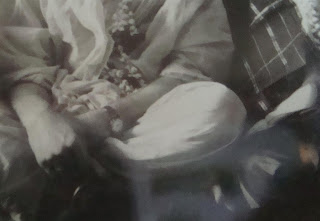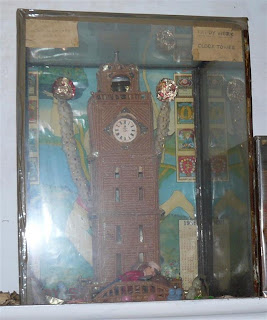This is the third and final part of this series.
Read also how some wrist watches survived my fiddling!
.........................................................................................
Wrist Watches
Possessing a watch was something special esp. in the first half of the 20th century, why, even until about 1980 or thereabouts. A watch was for many years the second important item, next to the ring, gifted by the bride's family to the bridegroom at weddings! Or should I say a watch was demanded by the bridegroom's side! It was gossip subject for inquisitive people during the wedding!
In the early part of the 20th century, people walked barefoot and only those well-placed in society wore sandals or shoes. Boys went to school barefoot and there are many instances of them getting their first footwear when they finished school and not a watch! Now we see even kids boasting of a dozen watches in myriad designs!
Come to think of it, we also have 'use and throw watches' that are also sold by weight! It is no longer a 'luxury item' or a special gift at weddings.
My first watch came in 1975 of which I brief as I go on. There were a few watches at home that belonged to my elders.
This Favre Leuba Zenith tops them all. My grandfather's most cherished watch. It was his wedding watch - 1914. He wore it with great pride and I have seen him enthusiastically show it to people that asked about it and always mentioned '1914'.
The lovely snow-white dial
Front door can be opened - probably to aid the blind to feel the hands and know time.
Silver case number, inside
The machine is beautiful to look and the sight of the balance wheel's oscillation is one to behold!
This Favre Leuba Zenith stands out whitest on his wrist as he gets a trophy for golf from His Highness. Once the case's strap hook had snapped. He got it soldered from a known jeweler in the same street not trusting any other jeweler near his office, where there were many. That's how close to his heart it was.
After the departure of him and also my father, I began to use it often. When I was wearing it during a picnic, my hand clapping made the machine to jump out and break a few parts. I felt extremely bad and I thought that was the end of this. Years later, I discovered a colleague who knew my father and also a 'trustworthy' hobby clock smith. "Please put it back in motion at any cost" I requested him when I handed it over. After many reminders and 2-3 years, he said he had fabricated a tiny part as it was unavailable anywhere and that it was working and he had kept it for testing, much to my relief. After some time, he finally handed it over to me. I was absolutely delighted to see it ticking again. Mr.Khabade collected his nominal fee for this extraordinary work. Lesson learnt, I am now choosy about when to wear it and careful while doing so.
May be in the early 40s, another watch came to my grandfather in the form of this "Skymaster".
It was a gift from one Mahadevappa who had toured Europe with the Royal Party that included the Yuvaraja of Mysore. This was another machine I meddled with and repaired it during my 'learning process'! This is still my favourite, because of that square design in the centre and the magnifier for the date.
I was with him when this picture was taken in a studio in 1972 or so. He was taking me to his office that evening. Hope you noticed the Skymaster.
This Enicar was my late uncle's. In 'irrepairable' condition because its 'escape wheel' is damaged and is unavailable.
My father used the Enicar or any of the two above when his favourite "Lamania" fell into the hands of a known hobby-clock smith in the next street. This man never returned it, despite me asking him at the behest of my father to return even if it is unrepaired years later. He never showed it to me in whatever condition it was. So one can understand its fate. As a replacement and after much pestering, he gave a very cheap watch which did not work for long. I think my father had bought that Lamania during his stay in Bombay in the early 50s from his very modest earnings while working for the Films Division at a sound recordist. That was the end of Lamania. I only got to observe it in a few of his older pictures:
Seen here during his wedding
Lamania is seen here. I don't know if the cuff was pulled up intentionally! I sometimes used to do that with my first watch and while wearing a full slack so that others could notice my wearing it!
Wearing a watch to school was really something! Hardly anyone wore because even adults at home bought their watches after they joined jobs. Those who had an extra watch at home would wear it and show off with classmates in school!
Though these watches were at home, I felt shy to wear them - don't talk of meddling their machines! It was only after a watch came to me that I got over that feeling. It was my first watch - a gift by an uncle on the occasion the cousin's wedding. It was some lesser known Swiss brand and belonged to her brother who had died prematurely, some years before the wedding. Gifting this to me for that occasion saved them a few rupees! A watch was a big thing even in the 70s.
Long later, I replaced its machine with a 'quartz movement' and gave it off to my FiL who was in urgent need of a watch at that time. I used to see him use it for some more years. It was a victim of the learning process.
My 'achievements' in meddling these time machines
I used that watch for some years and when it developed a snag, I got curious. I saw a clock smith in me. I opened it with some crude tools - one was a tweezer I had bought for zoology specimen dissection at college! I accidentally bent a spring and its condition still worsened. Handling the tiny machine requires very steady hands. Skill comes from persistent practice. Drunkards cannot become clock smiths. I had already 'laid my hands' on the two alarm clocks which 'in the end', met their premature end!
During my market errands, I got clues while inquiring for spares for the watches that suffered under my hands. I also observed how the professional smiths handle the tiny parts. I bought the basic tools like the eye piece, screw drivers, little trays and boxes at a watch spares shop. I wanted to try and see for myself what could be done to make it work again.
I learnt that the balance wheel is like the human heart. If it stops, the machine goes lifeless. But the "machine's heart" is replaceable. Handling the balance wheel with its 'hair spring' is a highly skillful job which I could never master, despite being a teetotaler! It was a tough learning process nevertheless. I could remove and replace all the parts after cleaning them with 'aviation petrol' and putting oil to the 'jeweled parts'. This was also the beginning of my hobby as a clock smith, which helped me maintain the watches and clocks at home and even helped a few of my friends that knew of my ability at this. For things that were beyond my basic skill, I had to engage professional help.
I have spent hours searching the floor and desk, for those nano screws that slipped from the tweezer grip! I had even used magnets to 'find' them because I thought then that the broom and brush might still worsen the situation! I used to wonder how they even manufactured such tiny parts with precision.
That Favre Leuba is one watch I never wanted to open even though the temptation was there. But for once, wisdom prevailed.
After my entry to a job I bought my first watch for Rupees 225. I sold it off after a few months for 175 to a colleague and bought another similar watch in 1984 only because I liked the design on this one! It is the traditional spring wound watch from Hindustan Machine Tools. This one, still fine:
In the late 80s, quartz watches became popular. I found out over time that they are reliable and durable. My next watch was a quartz watch brought for me from Singapore by a friend for Rupees 200. It worked nicely for almost 20 years when its life ended in 2007.
Like many organizations that presented employers with watches when they completed many years of service, there came a day when I got one too from mine.
::||::||::||::||::||::
Another dial design I made on the back side of the original dial of this clock which did not suit my taste. I have designed the hands here.
The new generation is never satisfied with one or two.
Some Swiss Watches through the 'window':
Showcases at night
Cuckoo clocks are famous in Switzerland
"Expensive cheaper watches"!!
Huge shop full of watches
Not unexpectedly... expensive.
More watches and mementos
TIME AND TIDE WAITS FOR NO MAN.
























































